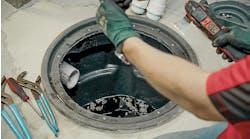Rhone Resch, CEO of Solar Energy Industries Association (SEIA), www.seia.org, recently noted that sales of solar thermal water systems enjoyed a 50% increase in sales for this past year! That's great news, but take a look at the roofs in your community the next time you stand atop an urban roofscape — survey those acres of flat roofs — or while you drive through suburbia — study the angled roofs along the way (assuming you're viewing the southern side). I think you'll agree that the solar surface has barely been scratched, and that's a great bit of news for plumbers! After all, who better to handle these solar thermal installations?
Competent licensed plumbers have the base knowledge that gives them insight to several risks associated with heating and storing water. But, that does not mean training is not required to incorporate safe solar practices — it is. Without proper training, efficiency and operation suffer while safety is compromised. Resch and I spoke at some length about the safety issues and training at Solar Power International (SPI), held in Anaheim, Calif., Oct. 27-29.
Some issues to consider if you're thinking of joining this emerging solar thermal revolution (and I'm urging you to do so and to join SEIA and perhaps most importantly, to get the proper training): safety for you and your employees, and safety for your customers.
Proper training for you and your employees will cover safety issues that incorporate fall protection from roofs, a leading cause of death and debilitating injuries for roof-top work that we've covered in this column previously. Other safety issues you need to learn about are using OSHA-compliant gear and knowing, in advance, who to call for emergency response. Once you have a workable safety plan combined with employee safety training, use it to obtain a deduction in your insurance premiums.
Customer safety
So, what's up with safety issues on the customer side?
Scalding: Solar thermal systems need a storage tank for depositing harvested liquid-sunshine energy — most likely while the owners are not home — for use when the sun is not shining. Over the course of the year, and dependent on the system's solar collectors installation, there will be months when the solar thermal system will produce as much, if not more, stored liquid sunshine than will be used by the occupants. Since no aquastat can be added to turn off the sun, you must provide scald-protection by adding an ASSE listed (meaning it has been certified for compliance) 1017, 1016, combination 1017/1016, or the newly established 1070 mixing valve, so that downstream delivery temperature can be limited to 120°F or less. You are responsible to adjust and set these devices, record those settings, and if your local inspector isn't checking, require them to record this information to CYA (cover your ass-sets). I'd also suggest you educated the homeowners on this issue, using this as a sales tool when you're meeting them for the first time about the solar system design and sale.
Bacterial amplification: It's been a while since we've discussed this issue, but solar thermal systems differ greatly from stand-alone gas, oil or electric tank-style water heaters where you can set the water temperature high enough (140°F) to pasteurize the water and kill off most of the free-roaming bugs — like Legionella bacteria. Solar storage vessels will see a wide range of warm-water storage temperatures that often fall below 120°F where bacterial amplification can become rampant. Several manufacturers are beginning to be proactive regarding this issue and offer solar system storage tanks with a daily (typically an electric element) treatment that raises the storage temperature to a minimum of 140°F for 30 minutes.
One popular notion is that a solar tank in series with a standard tank-style water heater will be acceptable for bacterial eradication by “cooking” the bugs in the fossil-fuel powered tank. Bear in mind: it takes a minimum of 20 minutes contact time at 140°F to kill off most, not all, of the free-roaming bugs. When will they get that ride to perdition? When there's a draw at the points of use, and there's a better-than-ever chance some of the buggers will be in and out through the tank before either encountering 140°F water or the required contact time.
Another installation method gaining popularity that has virtually no affect on bacteria is installing solar thermal that runs through a tankless water heater to step in as needed to finish the job of hitting the 120°F target temperature. In this scenario, your only real opportunity to pasteurize the potable hot water resides in the solar tank.
Energy conservation: I like closed loop systems for this reason — they use the least energy while harvesting energy. Open drain-back systems are good too, but with electricity deregulation in Pennsylvania just around the corner and ECM motor technology granting us low-watt circulators, including DC models just over the horizon, we have the potential to save our customers a second bushel of energy on the thermal transfer side. This parasitic energy drain has largely been ignored, but is now emerging as the next frontier in conservation. With the potential solar harvest of six hours per day, or more, that's a minimum of 2,190-run hours per year. The savings seem relatively small unless you look at them over the expected 30-year life expectancy for thermal solar systems. Simple payback for the ECM circulator is less than 10 years, and the next 20 years yield an added financial harvest for your customers.
Dave Yates owns F.W. Behler, a contracting company in York, Pa. He can be reached by phone at 717/843-4920 or by e-mail at [email protected].
All Dave Yates material in print and on CONTRACTOR's Web site is protected by Copyright 2009. Any reuse of this material (print or electronic) must first have the expressed written permission of Dave Yates and CONTRACTOR magazine. Please contact via email at: [email protected].

